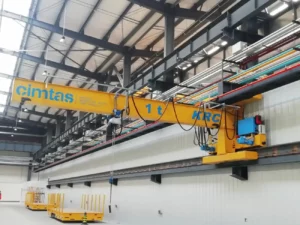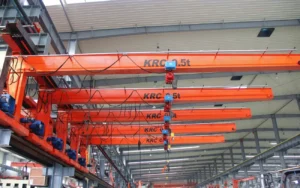key differences between Wall Bracket Jib Cranes and Wall Mounted Jib Cranes to help visualize the distinctions:
| Feature |
Wall Bracket Jib Crane |
Wall Mounted Jib Crane |
| Support Mechanism |
Multiple brackets along the beam |
Single mount point at/near the pivot |
| Load Capacity |
Higher, due to distributed load support |
Lower, due to concentrated load |
| Reach |
Longer spans possible |
Generally shorter reach |
| Installation |
More complex, requires robust structure |
Simpler, fewer modifications needed |
| Space Utilization |
Requires more space, less compact |
More compact, suitable for tighter spaces |
| Cost |
Potentially higher due to complex installation |
Generally lower due to simpler installation |
| Structural Impact |
Spreads load, requiring stronger, wider wall support |
Concentrated load, less structural impact |

The terms “wall bracket jib crane” and “wall mounted jib crane” often refer to similar types of equipment, but there are subtle differences in their design and applications. Here’s a breakdown of each type to clarify those differences:
Wall Bracket Jib Crane
A wall bracket jib crane is attached to a wall or a vertical structural column. Its key features include:
- Support Mechanism: This crane uses wall brackets that are typically spaced apart, providing support along the length of the jib’s beam. This arrangement distributes the load more evenly along the wall.
- Load Capacity and Reach: Due to the distributed support, wall bracket jib cranes can often handle slightly heavier loads and have longer spans than some other wall mounted types.
- Installation: It requires robust wall structures for mounting, as the stress is spread across multiple points on the wall.
- Cost: These might be costlier due to the need for additional structural support and more complex installation.
Wall Mounted Jib Crane

A wall mounted jib crane is also fixed to a wall or structure but typically involves a different mounting method:
- Support Mechanism: This type of crane generally uses a single mounting point at or near the pivot of the jib. The entire load exerted by the crane is concentrated at this single point.
- Load Capacity and Reach: It usually supports less weight and a shorter reach compared to the wall bracket jib crane, due to the concentrated load.
- Installation: It is simpler and potentially cheaper to install, as it requires fewer modifications to existing structures and less hardware.
- Space Utilization: Wall mounted jib cranes are often more compact and can be a better option in tighter spaces.
Choosing Between the Two
The choice between a wall bracket jib crane and a wall mounted jib crane largely depends on:
- Available Structure Strength: The structural integrity of the wall or column where the crane will be mounted.
- Space Constraints: The available space and how the crane’s presence might affect movement or other operations within that space.
- Load Requirements: The weight and size of the materials to be lifted and moved.
- Budget Constraints: The initial installation cost versus long-term usability and maintenance.
Each type of crane offers specific benefits suited to different industrial needs, making it important to assess the operational requirements and structural conditions before making a selection.



